Brown Marmorated Stink Bug (BMSB) Pest Alert
Brown marmorated stink bug (Halyomorpha halys), a native pest of Asia, was first identified in North America in Pennsylvania in 2001. It has since spread throughout most of the United States. It is a very serious pest that feeds on more than 100 different plant species. In 2010, an estimated loss of $37 million due to brown marmorated stink bug feeding was reported by the apple industry in the Mid-Atlantic States.
The stink bug is an excellent hitchhiker and can be moved in shipping containers, wood, packing material, cargo and vehicles. It is also a nuisance to homeowners as the adults aggregate on and in buildings while seeking warm overwintering sites.
Brown marmorated stink bug was first detected in British Columbia in 2015 and is now established in urban areas of southwest British Columbia including Vancouver, Fraser valley and Vancouver Island and Kelowna.
Identification
Adult: Shield-shaped, 13 – 17 mm long, brown marbled appearance, alternating brown and white markings on the outer edge of the abdomen; can be distinguished from other stink bugs by the presence of distinctive white bands on the last two antennal segments (see adult picture on left). Adults may be confused with other native brown stink bugs and western conifer seed bugs.
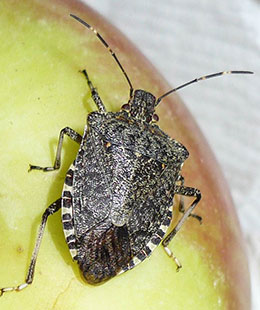 Adult brown marmorated stink bug. Note white bands on antennae
Adult brown marmorated stink bug. Note white bands on antennae
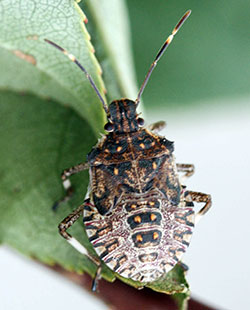 Brown marmorated stink bug, fifth instar nymph
Brown marmorated stink bug, fifth instar nymph
Native Look-Alike Bugs (NOT Brown Marmorated Stink Bug):
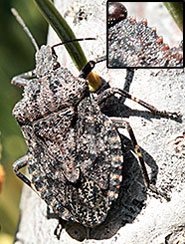 Rough stink bug has rough skin and spines on the shoulder
Rough stink bug has rough skin and spines on the shoulder
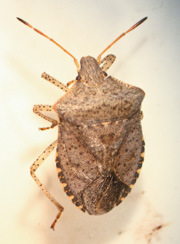 Common brown stink bug has no white bands on the antennae
Common brown stink bug has no white bands on the antennae
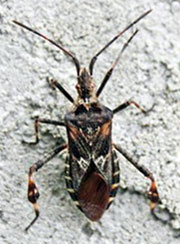 Western conifer seed bug has no white bands on antennae, and leaf-like back legs
Western conifer seed bug has no white bands on antennae, and leaf-like back legs
Egg: Spherical, white or pale green, 1.6 x 1.3 mm; laid in clusters of 20 – 30 eggs on the underside of leaves.
Immature (nymph): There are 5 immature stages. Nymphs range in size from 2.4 – 12 mm in length and do not have fully developed wings. Ist instar nymphs are bright orange to red in colour; 2nd instar nymphs are black, tick-like; later instars are pear-shaped, brown with white markings on abdomen and legs and white bands on last two antennal segments.
Hosts
Brown marmorated stink bug attacks tree fruits, berries, grapes, vegetables and ornamental plants. Hosts in British Columbia include backyard Asian pears, apples and apricots, hazelnuts, wild chokecherries, maple, lilac, honey locust, tree of heaven, mountain ash, ash, shiny cotoneaster, catalpa, magnolia, snowberry, scarlet firethorn, rose, rose of Sharon, cedar, Virginia creeper, sumac, hops, runner bean, Oregon grape, privet, gingko, handkerchief tree, oak, ornamental prunus, clematis, sunflower, thimbleberry and elderberry.
Life cycle
Adults overwinter inside buildings or in protected areas and emerge in early spring. Each female can lay up to 400 eggs throughout the summer on host plants, resulting in overlapping nymphal stages. Eggs hatch in 4–5 days; nymphs mature in about 5 weeks depending on temperature. One to two generations per year are reported in the United States, one generation in British Columbia and up to 6 generations in Asia.
Damage
Both adults and nymphs feed by inserting their mouthparts into the flesh of fruit or vegetables. Feeding punctures result in small dead areas on fruit, vegetables and leaves. Brown marmorated stink bugs can be a contamination issue for grapes because the presence of a few adults at crush can taint wine.
Management
Biological control: Trissolcus japonicus that attack the eggs of brown marmorated stink bugs in Asia have been found in the United States and Canada. Other predators such as spiders, ladybugs, red velvet mites and lacewings will feed on brown marmorated stink bug eggs.
Chemical control in commercial crops: the few registered insecticides for brown marmorated stink bug control in Canada provide only suppression of the pest.
Homeowners: Low numbers of brown marmorated stink bugs can be removed by hand, sweeping or a shop vacuum. Prevent entry into the home by sealing off any access points. The use of insecticides for controlling brown marmorated stink bugs in the home is not recommended.
For additional information, check:
Help us look (PDF, 2.6 MB) for beneficial insects of BMSB.
Report suspect BMSB
- Brown Marmorated Stink Bug Factsheet - identification and management (PDF)
- Brown Marmorated Stink Bug - Brochure for Homeowners (PDF)
- Brown Marmorated Stink Bug - Pest Alert Postcard (PDF)
- Controlling Brown Marmorated Stink Bug in Your Home (PDF)
